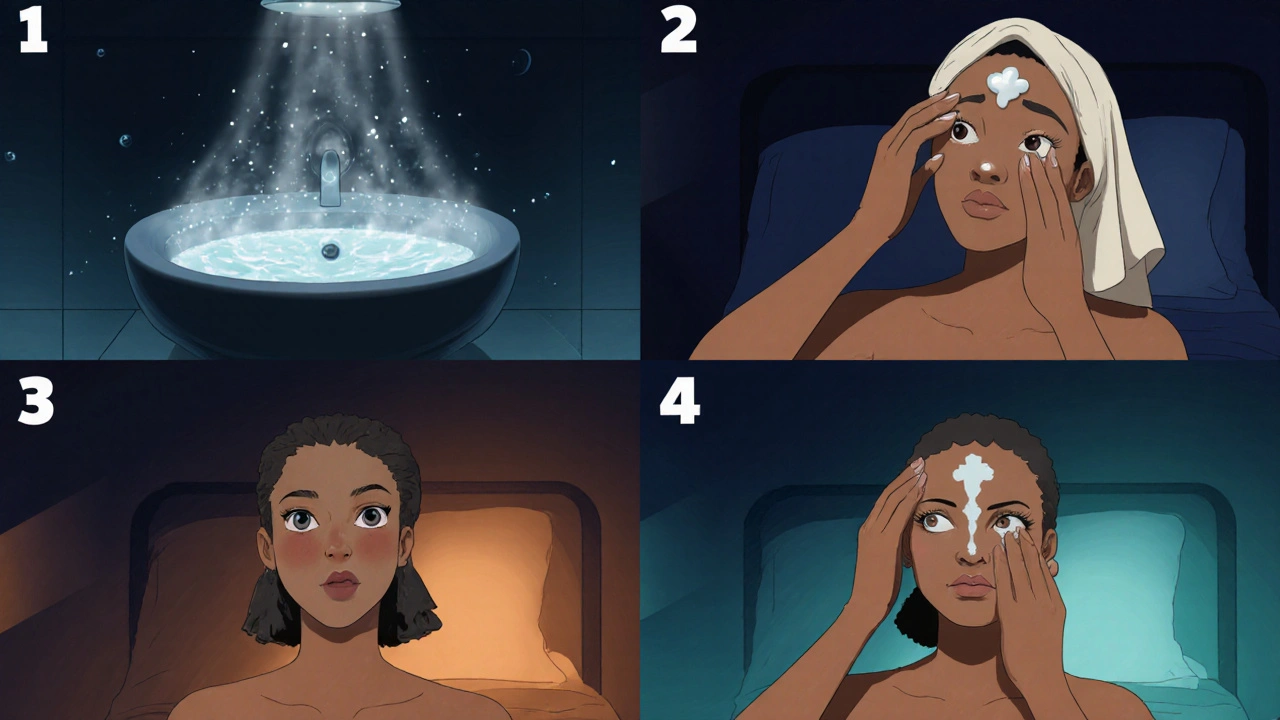Tazarotene Guide: Uses, Benefits, and How It Works

Tazarotene Dosage Calculator
Recommended Tazarotene Concentration
This tool helps determine the most appropriate tazarotene concentration based on your skin type and experience with retinoids. Always consult your dermatologist before starting any new medication.
Recommended Tazarotene Concentration
When you’ve tried over‑the‑counter gels and nothing sticks, Tazarotene a prescription‑strength topical retinoid used to treat acne and psoriasis often shows up as the next step. It’s not a miracle cure, but for many people it clears stubborn breakouts and smooths plaque psoriasis in weeks rather than months.
What Is Tazarotene and How Does It Fit Into the Retinoid Family?
Retinoid a class of vitamin A derivatives that influence skin cell growth and inflammation includes familiar names like tretinoin and adapalene. Tazarotene stands out because it’s more potent and is formulated as a cream, gel, or foam that can penetrate deeper layers of the epidermis. The drug binds to retinoic acid receptors (RAR‑β and RAR‑γ), turning on genes that speed up cell turnover and calm inflammatory pathways.
Approved Uses: Acne, Psoriasis, and Beyond
The U.S. FDA the Food and Drug Administration, the agency that regulates medicines in the United States cleared tazarotene for two main indications:
- Acne vulgaris the common form of acne characterized by comedones, papules, and pustules in patients 12years and older.
- Plaque psoriasis a chronic autoimmune skin disorder that produces thick, scaly plaques in adults.
Dermatologists also prescribe it off‑label for melasma, photo‑aged skin, and even as a maintenance step after laser resurfacing.
How to Use Tazarotene Correctly
Using a potent retinoid the wrong way can backfire. Follow these steps for the best balance of results and tolerance:
- Start with a tazarotene concentration of 0.1% (cream or gel) if you’ve never used a prescription retinoid.
- Apply once daily in the evening to clean, dry skin. Wait 20-30minutes after washing to ensure the surface is fully dry.
- Use a pea‑size amount for the entire face. Spread thinly; more isn’t better.
- Moisturize after the product has absorbed (about 10minutes). A gentle, non‑comedogenic cream works well.
- Introduce a broad‑spectrum sunscreen (SPF30+) each morning. Retinoids increase photosensitivity.
If irritation appears, cut back to every other night for 2-3weeks, then resume nightly use once tolerance improves.

What the Numbers Say: Efficacy Evidence
Several double‑blind, placebo‑controlled trials back up the hype:
- In a 12‑week study of 215 teens with moderate acne, 0.1% tazarotene reduced inflammatory lesions by 55% versus 12% with vehicle.
- A 16‑week trial for plaque psoriasis (n=180) showed a 71% improvement in the Psoriasis Area Severity Index (PASI) for the 0.1% foam, compared with 28% for the control.
- Long‑term safety data (up to 2years) indicate that skin thinning is rare when the product is used as directed.
These results make tazarotene one of the most evidence‑based topical options for both conditions.
Safety Profile and Common Side Effects
Because it’s a strong retinoid, you’ll likely notice some skin reactions in the first weeks:
- Redness, peeling, or a burning sensation - usually peaks at week2 and fades.
- Dryness or flaking - mitigate with a richer moisturizer.
- Temporary worsening of acne (known as “purging”).
Rare but serious concerns include:
- Severe contact dermatitis - stop use and see a dermatologist.
- Photosensitivity - always pair with sunscreen.
Pregnant or nursing individuals should avoid tazarotene because systemic absorption, while low, could pose a risk to the fetus.
How Tazarotene Stacks Up Against Other Topical Retinoids
| Attribute | Tazarotene | Adapalene | Tretinoin |
|---|---|---|---|
| Potency | High | Medium | High |
| Typical Concentration | 0.05%-0.1% | 0.1%-0.3% | 0.025%-0.1% |
| Prescription Status (US) | Prescription‑only | OTC (0.1%); Prescription (0.3%) | Prescription‑only |
| Primary Indications | Acne, Plaque Psoriasis | Acne (including comedonal) | Acne, Photoaging |
| Typical Onset of Irritation | Week1-2 | Week2-3 | Week1-2 |
If you need a retinoid that also tackles psoriasis, tazarotene is the only one in this trio with that label. For beginners who fear irritation, adapalene’s slower onset may feel gentler.

Quick Takeaways
- Tazarotene is a prescription‑only, high‑potency topical retinoid.
- Clinically proven for acne vulgaris and plaque psoriasis.
- Start low, apply sparingly, and always use sunscreen.
- Expect mild irritation for the first 2weeks; severe reactions warrant a doctor’s visit.
- Compared to adapalene, it works faster on psoriasis but may cause more initial dryness.
When to Call a Dermatologist
Even though many patients manage tazarotene at home, you should seek professional advice if you notice any of the following:
- Persistent redness or swelling after 4weeks.
- Blistering, oozing, or severe crusting.
- Signs of an allergic reaction - itching, hives, or swelling.
- Painful worsening of psoriasis plaques.
A dermatologist can adjust the concentration, suggest a combination therapy, or switch you to a different retinoid.
Frequently Asked Questions
Can I use tazarotene on my body or only on the face?
Yes, the cream or gel can be applied to the chest, back, or other areas affected by acne or psoriasis, but use a smaller amount per square inch to avoid excess irritation.
How long does it take to see results for acne?
Most users notice a reduction in new lesions within 4-6weeks, with the full benefit appearing around the 12‑week mark.
Is tazarotene safe during pregnancy?
No. It is classified as Pregnancy CategoryC, and doctors generally advise discontinuing use before conception and throughout pregnancy.
Can I combine tazarotene with other acne products?
Yes, but choose gentle partners. A mild benzoyl peroxide cleanser in the morning and a non‑irritating moisturizer at night work well. Avoid other strong exfoliants or high‑strength steroids unless directed by a dermatologist.
What should I do if I experience severe peeling?
Cut back to every other night, apply a richer barrier cream (like ceramide‑rich moisturizers), and keep the skin protected from the sun. If peeling persists beyond two weeks, see a dermatologist.

Garrett Williams
October 15, 2025 AT 19:40Give tazarotene a try and you might finally see those stubborn spots fade.
Rene Lacey
October 20, 2025 AT 10:46The journey of skin renewal mirrors the broader quest for self‑knowledge, reminding us that transformation is seldom instantaneous. Tazarotene, by binding to RAR‑β and RAR‑γ, initiates a cascade of gene expression that accelerates keratinocyte turnover. This molecular dialogue, while potent, requires the epidermis to adapt, much like a mind confronting new ideas. Patience, therefore, becomes a virtue not only in philosophy but in dermatology. When the first week ushers in mild erythema, it is the skin’s honest response to change. Rather than fearing this, one might view it as a herald of progress, an early sign that the retinoid is engaging its targets. The subsequent weeks, typically spanning two to four, often bring a reduction in comedonal blockage, as clogged pores uncouple and shed their burden. Clinical data, such as the 55 % drop in inflammatory lesions observed in a twelve‑week teen cohort, substantiate these observations. Yet numbers alone cannot capture the subjective relief of seeing a clear forehead after months of frustration. Moreover, tazarotene’s efficacy in plaque psoriasis, reflected in a 71 % PASI improvement, illustrates its dual capacity to modulate inflammation and hyperproliferation. This duality underscores a philosophical symmetry: the same agent can soothe both the visible and the unseen scars of the body. However, the pursuit of such benefits must be balanced with prudent stewardship of the skin barrier. Moisturizers rich in ceramides, applied after the product has absorbed, act as allies in preserving hydration. Finally, the indispensable role of sunscreen cannot be overstated, for even the most resilient retinoid‑treated skin remains vulnerable to UV‑induced damage. In sum, embracing tazarotene is an exercise in disciplined optimism, where scientific rigor meets personal perseverance.
johnson mose
October 25, 2025 AT 01:53Imagine your skin as a canvas, each cell a brushstroke waiting to be repainted. Tazarotene swoops in like a bold artist, dissolving the dull greys of clogged pores and peeling back the flaky veil of psoriasis. The key is restraint – a pea‑size dab, spread thin, lets the magic work without overwhelming the substrate. Pair it with a buttery moisturizer, and you’ll notice the dryness retreat like a tide receding from the shore. In short, think of it as a controlled wildfire that clears the dead growth, making room for fresh, vibrant tissue.
Charmaine De Castro
October 29, 2025 AT 16:00Starting low is the smartest move; 0.1 % is gentle enough for most beginners yet strong enough to show results. Apply it at night on clean, dry skin and wait before moisturizing to let it sink in. Consistent sunscreen each morning will protect you from the increased photosensitivity. Stick with this routine for a few weeks and you’ll likely see the first signs of improvement.
Mark Mendoza
November 3, 2025 AT 07:06👍 Tazarotene works faster than many over‑the‑counter options, especially for stubborn acne. 🌞 Just don’t skip the SPF – the sun and retinoids are a risky combo. 🙌 Keep your moisturizer rich and you’ll tame most of the dryness.
Dan Tourangeau
November 7, 2025 AT 22:13Use a pea‑size amount; more does not equal faster results. Moisturize after absorption and always wear SPF.
Bernard Valentinetti
November 12, 2025 AT 13:20Ah, the marvel of tazarotene, a true titan among retinoids; it binds, it penetrates, it commands the epidermal narrative, and yet, it demands reverence, patience, and a disciplined regimen, lest chaos ensue. One must, in the very first week, anticipate a symphony of redness, peeling, perhaps a whisper of burning – all of which are merely the heralds of cellular rebirth, a renaissance of skin, if you will; ignore them, and you court the folly of premature abandonment. The application protocol, dear reader, is sacrosanct: cleanse, dry, wait – precisely twenty‑to‑thirty minutes – then an infinitesimal dollop, spread like a thin veil, followed by a barrier of moisturizer, and finally, the unyielding shield of broad‑spectrum SPF thirty or higher, each step an oath to efficacy; deviate, and the promise wanes. Moreover, the literature, replete with double‑blind trials, confirms a fifty‑plus percent reduction in lesions, a statistical testament to its potency, a beacon for those besieged by acne's tyranny; let us not forget the psoriasis data, a seventy‑one percent PASI improvement, a triumph of pharmacology, a testament to versatility. In summation, cherish this potent ally, respect its might, and your dermal landscape shall transform, blossoming anew, radiant and unblemished, a living ode to the science of retinoids. 😊
Kenneth Obukwelu
November 17, 2025 AT 04:26From the streets of Seoul to the clinics of New York, retinoids have become a global language of skin care, and tazarotene speaks with a distinct accent of potency. It bridges the gap between acne and psoriasis, offering a rare dual‑action that many cultures have long sought in a single potion. While some may shy away from its initial sting, the cultural narrative celebrates perseverance – a rite of passage toward clearer skin. Pairing it with traditional moisturizers, such as shea butter in West Africa or rice‑based creams in Japan, honors both modern science and heritage wisdom. In this cross‑cultural dialogue, tazarotene emerges not just as a drug but as a shared story of rejuvenation.
Josephine hellen
November 21, 2025 AT 19:33Embarking on a tazarotene journey can feel like stepping onto an uncharted path, but optimism lights the way like a lantern in the night. Each night you apply that modest pea‑size amount, you are planting a seed of transformation, trusting that the soil of your skin will nurture it into vibrant health. The first few days may bring a little redness, a subtle reminder that change often arrives with a hint of discomfort, yet this is merely the skin’s way of announcing that the old, clogged cells are making way for the new. Remember, the universe rewards consistency; so keep the routine steady, and the results will follow like sunrise after a long, dark evening. By week four, many users begin to notice a reduction in fresh breakouts, a sign that the inflammatory cascade is calming under the retinoid’s guidance. By week eight, the texture smooths, the plaques thin, and the confidence that once hid behind blemishes starts to re‑emerge. It is also wise to celebrate the small victories – a single clear spot, a day without the dreaded flare – for they are the building blocks of lasting success. Pair your regimen with a nourishing moisturizer, perhaps one enriched with hyaluronic acid, and never, ever skip the sunscreen; the sun is the eternal antagonist in this story. As weeks turn into months, the cumulative effect of tazarotene’s gene‑level influence will become evident, and you’ll find yourself looking into mirrors with a smile you haven’t seen in years. So stay the course, trust the science, and let optimism be your steadfast companion on this skin‑renewing adventure.
Ria M
November 26, 2025 AT 10:40The moment tazarotene contacts the epidermis, a cascade of molecular events ignites, each precisely choreographed by retinoic acid receptors. This choreography dismantles the hyperkeratinized structures that give rise to acne and psoriatic plaques, thereby restoring order to the cutaneous landscape. One must respect the protocol: cleanse, dry, wait, apply a minuscule amount, then moisturize and shield with SPF, for deviation can disrupt the delicate balance. Initial erythema, though alarming, represents the skin’s candid acknowledgment of transformation, a physiological overture to renewal. Consistency, not haste, is the governing principle; the skin remodels over weeks, not days. Clinical evidence, quantified in percentages, corroborates these observations, yet the subjective experience of smoother, clearer skin remains the ultimate testament. Should severe irritation persist beyond two weeks, the prudent course is to consult a dermatologist, not to abandon the regimen in frustration. Ultimately, tazarotene exemplifies how targeted pharmacology, when applied with discipline, can rewrite the narrative of chronic skin disorders.
Delilah Jones
November 28, 2025 AT 18:13That over‑the‑top description is a bit much – stick to the facts and keep it simple. The main takeaway is to follow the steps and protect the skin.